A Student’s Guide to College Applications
College Applications clip art
October 28, 2022
College applications are tedious, exhausting, and unnecessarily strenuous. And yet, for any student pursuing higher education, they tend to be unavoidable. Most applicants find the process too complicated, which is incredibly frustrating. This guide will give you a step-by-step approach to this admissions season.
1: Pre-Application
Before applicants actually begin their college applications, they have a couple of decisions to make. Which colleges you’ll apply to, what your budget will be, if college is even the right fit for you, etc. In this article, we’ll assume you already have these questions answered and are simply ready to begin applications.
However, to optimize your acceptance rate, you’ll want to also consider the factors of the colleges you’ll want to apply to, such as grade point average, class rank, and other criteria. For example, if you have a GPA of 3.2 but are applying to a school that has an average GPA of 4.0, you should invest your senior year in AP or Dual Credit classes that would boost your GPA. Before anyone freaks out about test scores, remember that most schools are test optional these days. If you believe your scores are not accurate to your capabilities, then don’t submit them.
Another resource you’ll want to research is a school’s Common Data Set, which is a collection of free public
information that a college will release about its school’s demographics. You’ll see how many students apply, how many are admitted, their GPA, etc. But more importantly, you can find out what the school values. For example, below is the Stanford Common Data Set from the 2021-2022 admission process. Each college will select aspects of applications that they find valuable on a scale of Very Important to Not Considered. With most popular or highly selective schools, interest level won’t be considered (which is a really fun way to say that they don’t care how many times you visit their website).
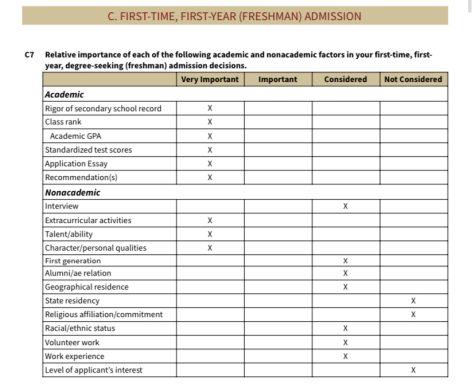
Now that you have all of these options, and you’re ready to apply, you choose which way you want to fill out the applications. One of the most popular avenues is the Common Application, which allows you to centralize your college information and applications. For this article, we’ll operate on the assumption that this is the way you’ll be applying to college.
2: The Common App
After downloading the Common App onto your phone or logging on to the website, you’ll start by filling out the Common Application section. It’s very general information, which will be used for each of your college applications. Essentially, the Common App is a massive time saver. If you didn’t use this application, and instead applied to all of these colleges separately, you would have to put this information in each form. This would eventually become tedious and exhausting, causing burnout. And you’ll want to save that burnout for later, trust the process.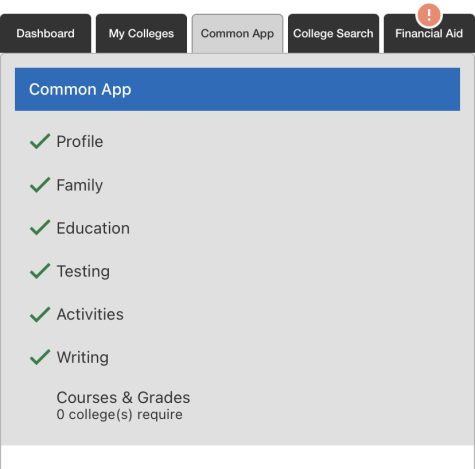
One aspect of the Common App that some users don’t like, however, is the essay portion. This is likely warranted since the essay prompts are not exactly inspired or incredibly thought-provoking. But the intentionally vague questions can leave applicants a lot of freedom, so they can submit a lot of different types of essays. For example, two students could choose the same prompt but end up with very different essays. This freedom can give you the chance to show off the best writing style for you, whether it be storytelling or writing a thoughtful introspection. Use this opportunity to play to your strengths, and feel free to ask English teachers to review and help edit your essay.
After filling out this portion of the application, you can go to “College Search” (pictured below) and select the colleges you want to apply to. These will be available to fill out on the “Dashboard” and “My Colleges” sections. When looking at the “Dashboard” section, you’ll be able to track your progress and your due dates.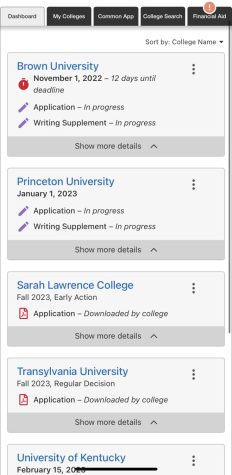
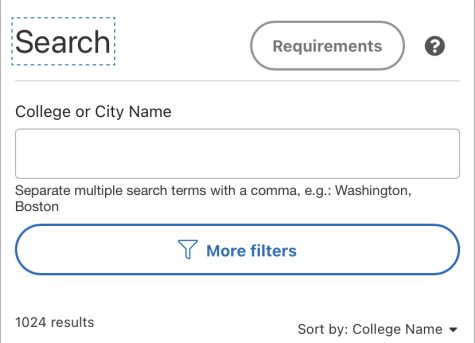
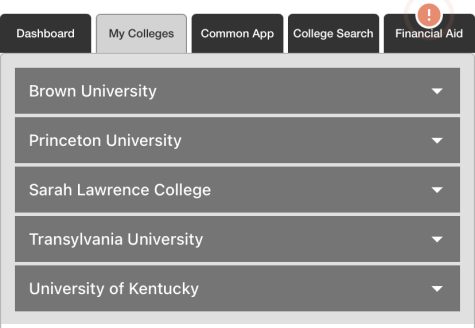
3: Individual College Applications
You’ll notice that most of the college admissions process is telling people things about you. Once you start the individual application process, you’ll press “Questions” and begin filling out the forms, similar to the Common App. These questions’ answers will only be available to the college they belong to, and each college has different questions. For example, one college might ask about your t-shirt size (cough Transylvania University cough) while another might ask about your interest in their honors college.
Some schools have another section, called “Writing Supplement”. These questions are usually short essays about various topics, to challenge applicants. They’ll be different types of essays, some may be hopeful or uplifting, while others might be asking about the saddest point in your life. Or you’re applying to Princeton University, and they ask what song the soundtrack to your life (a personal favorite) is.
Hopefully, you won’t overthink every response and rewrite it so many times you just want to throw away your computer. Not everyone is so lucky.
4: Recommendations and FERPA
Before choosing your recommenders, you’ll have to fill out the FERPA, under the “Recommenders and FERPA” section (most Common App sections are self-explanatory).
When filling out the FERPA, it’s best to choose to waive your rights to read your recommendation letters. It may seem like a bad idea since our current culture is full of vapid narcissists who want any validation, they can get their hands on (this author included), but in reality, colleges find that applicants who waive their rights to read their recommendation letters are likely more confident that they have good recommendations.

You’ll also want to begin choosing teachers that can give you good recommendations. For colleges that require more than one letter, you should ask teachers from multiple subjects, such as one from an English teacher and another from a math teacher. This exhibits that you are competent and apply yourself in multiple subjects. The best way to get your recommendation letters is to start as soon as possible and to start building a good rapport with your teachers so that they have more to say.
After you ask for recommendation letters, it’s time to request the letter through Naviance. First, you’ll go to the counseling office and ask for the recommendation letter form or as college advisors call it the “brag sheet”. You’ll send the information on the form to your teachers through emails, and then log on to Naviance.com and select “Colleges” and then “Letters of Recommendation”. After you reach this tab, you can fill out the requests (shown below). You’ll also want to send this information to your counselors so that they can work on your counselor recommendation and other forms.
5: Submitting the Common Application
This step is short and bittersweet, with you broke by the end. After completing every part of the application, you’ll go to “Review and Submit, ” fill out any remaining information and verify that your application is complete. During this step, you’ll also need to pay any application fees and check that everything is in order.
6: After the App and Transcripts
After submitting your applications, the college will send you the link to your application portal, where they will notify you of anything they need to receive or review. You’ll also be given the contact information of your admissions counselor and be able to discuss any questions you may have. During this process, you can visit the campus and fill out the FAFSA.
When you need to submit your transcripts, do so with Parchment.com. Log in and order your transcripts from BCHS, and don’t worry about the cost, since it will be free. If you have transcripts from anywhere besides BCHS, like Dual Credit classes, you’ll also need to order those transcripts from those organizations.
Q&A:
“When do you need to start working on the college admission process?”
The short answer is: as soon as possible. The sooner you start your applications, the less you stress about deadlines and the more time you have to decide where you want to go.
“Do I need letters of recommendation?”
It depends on the college, most schools require one or two, but for some, this is not a requirement. However, if you are allowed to send them, you should. Letters of recommendation exemplify your good qualities from another perspective and showcase a good rapport with your teachers. College applications can often feel like they aren’t fully showcasing your entire personality, and a great way to bypass this is through glowing recommendations.


